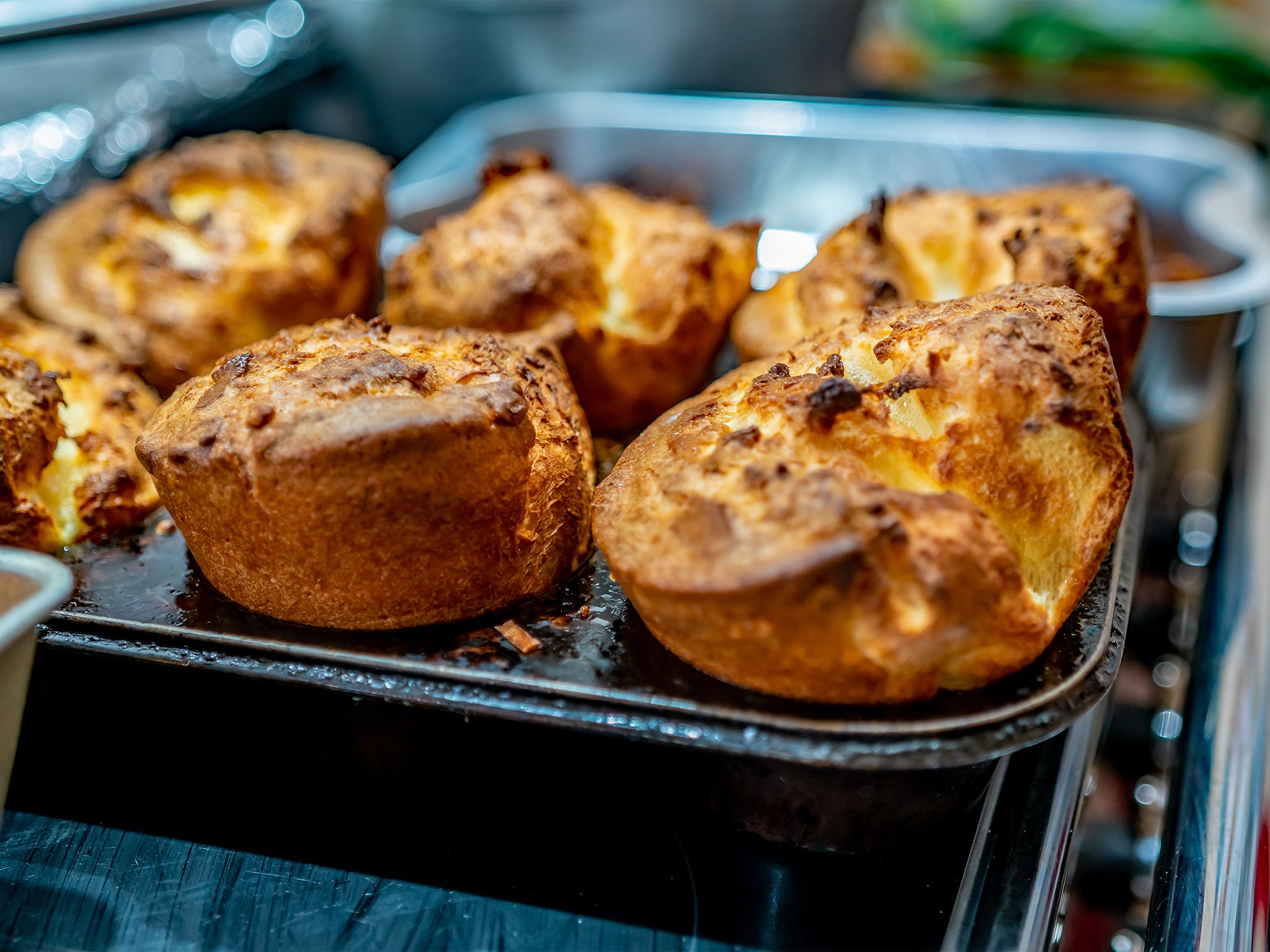Vegan Yorkshire puddings are not a myth – here’s a recipe to prove it
The highlight of the McCartney Christmas dinner table is the humble plant-based Yorkie. Now it can be on yours too, says Julia Moskin

Your support helps us to tell the story
From reproductive rights to climate change to Big Tech, The Independent is on the ground when the story is developing. Whether it's investigating the financials of Elon Musk's pro-Trump PAC or producing our latest documentary, 'The A Word', which shines a light on the American women fighting for reproductive rights, we know how important it is to parse out the facts from the messaging.
At such a critical moment in US history, we need reporters on the ground. Your donation allows us to keep sending journalists to speak to both sides of the story.
The Independent is trusted by Americans across the entire political spectrum. And unlike many other quality news outlets, we choose not to lock Americans out of our reporting and analysis with paywalls. We believe quality journalism should be available to everyone, paid for by those who can afford it.
Your support makes all the difference.The way Paul McCartney remembers it, the centerpiece of his family’s first vegetarian Christmas dinner, in the late 1970s, was a slab of macaroni and cheese.
“I wanted something to carve,” he said in a phone interview recently. Mary McCartney, his daughter, said the “macaroni turkey” was an early success: cooked in advance, shaped into a roll and ceremonially turned out onto a platter.
Paul McCartney was raised in Liverpool in the 1950s on a traditional meat-and-two-veg diet. But as young parents, he and his American wife Linda McCartney famously came to believe that eating animals was unethical – then a fringe belief in Britain, in the same counterculture bucket as mindfulness, yoghurt and pacifism. Still, a Christmas feast without its meaty centerpiece of roast beef and Yorkshire pudding seemed a little absurd.
“We had to find something to put in the middle of the plate,” he said.
Nearly 50 years on, the middle of the plate has shape-shifted. Instead of a central protein surrounded by vegetables and starch, a spread of plant-based dishes can easily fill any plate.
And Mary, a lifelong vegetarian-leaning-toward-vegan, has developed a knack for recipes that satisfy all kinds of eaters, including her four young-adult sons. Her cooking show, Mary McCartney Serves It Up, on Discovery+ focuses on entertaining: her guests are uncritical pals like Reese Witherspoon and Oprah Winfrey, who cheerfully announces that she has never before – despite being in her late 60s – made dip.
Paul said in the interview that his palate first opened up in London in the 1960s, where restaurants served food that he’d never encountered in Merseyside. He was exposed to ethical vegetarianism in 1968, during the Beatles’ brief but influential time studying meditation in Rishikesh in northern India. Ahimsa, the principle of not harming fellow creatures, underlies the vegetarian traditions found in Hinduism, Buddhism and Jainism (Ringo Starr, McCartney said, brought along a suitcase full of British baked beans in case he didn’t like the food).
By 1980, McCartney’s strictly vegetarian diet was so well known that while he was in detention in Japan, awaiting deportation on charges of possessing 7.7 ounces of marijuana, The New York Times reassured readers that he was provided with vegetarian food.
Mary said she and her three siblings (all of them vegetarians) have raised the next generation as they were raised: vegetarian at home, but with free range to explore outside (naturally, sticking to a plant-based diet is easier for families of fabulous wealth in possession of an organic farm).
She said she never missed the meat at Sunday dinners or on holidays: the great treat was crisp, lofty, custardy Yorkshire puddings.
“It’s the highlight of the Sunday roast,” she said. Tradition calls for a small amount of flour, bound in eggs and milk and baked in the same pan used for roasting a joint of beef. No leavening is used: the screaming-hot beef fat and high oven temperature mean that the pudding puffs and then deflates into a crisp-but-custardy mass, ideal for sopping up gravy.
To achieve all of that without eggs, milk or animal fat, McCartney turned to aquafaba, the liquid in which chickpeas are cooked and canned and a staple ingredient in modern vegan baking because it can thicken, bind and foam rather like egg whites. That led to chickpea flour, which not only browns, but also produces dense batters that hold moisture well. She added baking powder for lift, vinegar to react with the baking powder and generous amounts of oil for each muffin cup. The result is a crisp, savoury little muffin with fluffy, tender insides and a well on top to hold gravy.
It’s a long way from the early McCartney family experiments with vegetarian entrees like stuffed vegetables and murky ragouts, McCartney said. “I thought I would never be able to eat ratatouille or vegetable couscous again in my life.”
Vegan Yorkshire puddings
By: Julia Moskin
Traditional Yorkshire puddings, like popovers and soufflés, rely on eggs and dairy for their crowning puff and custardy center. Vegan cooks use neither, so this savoury recipe is a particularly impressive workaround. The structure here comes from protein-rich chickpea flour and aquafaba, Italian for “chickpea water”, and the rise from baking powder and cider vinegar. The recipe needs to be followed closely for best results, particularly the oven temperature, the material and size of the muffin tin (metal and standard 85g cups) and the amount of oil in each cup.
Makes: 9 popovers
Total time: 1 hour, 20 minutes
Ingredients:
425g tin chickpeas
1 tsp apple cider vinegar
90g all-purpose flour
85g chickpea flour (garam flour)
¼ tsp baking powder
½ tsp fine sea salt
Vegetable oil, such as grape seed or canola, for the muffin tin
Method:
1. Drain the chickpeas, reserving 140g aquafaba (reserve the chickpeas and any remaining liquid for another use).
2. In a large pitcher or bowl, whisk the aquafaba, vinegar and 350ml water together. Sift the all-purpose flour, chickpea flour and baking powder into a medium bowl. Add the salt and whisk together.
3. Pour the combined liquids into the dry ingredients and whisk together until smooth and bubbly, about 30 seconds. Pour back into the pitcher and refrigerate for 30 minutes.
4. While the batter chills, heat oven to 220C.
5. Using a standard 12-cup metal muffin tin, preferably nonstick, add 1 teaspoon vegetable oil to each of 9 cups. About 10 minutes before the batter is done chilling, place the oiled tin in the hot oven to heat.
6. Carefully remove the muffin tin from the oven. Stir the batter and pour into the muffin cups; the batter should sizzle vigorously as you add it, and each cup should be nearly full. Return to the oven.
7. Bake for 30 minutes. The puddings will rise, then fall, possibly making a well on the top. Turn down the heat to 200C and bake about 10 minutes more, or until the tops are deep golden brown and the insides are cooked through and just dry (peer into the well to check; the inside should be matte, not shiny). Remove from the oven, let the puddings rest for about 3 minutes, then use a spoon or spatula to lift from the tin and serve immediately.
© The New York Times



Join our commenting forum
Join thought-provoking conversations, follow other Independent readers and see their replies
Comments